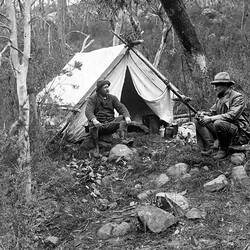BUTCHER BIRD (Cracticus destructor, Temminick)
Geographical Distribution - Queensland, New South Wales, Victoria, and South Australia.
Nest - Open, basin-shaped, compactly constructed of fine dead twigs, lined with dry yellowish grass or with rootlets, casuarina needles, &c., and usually situated well up inn the forked branches of trees, in mistletoe clusters, &c. Dimensions over all, 7 inches by 31/2 inches in depth; egg cavity, 3-3/4 inches across by 2-1/4 inches deep. (See illustration.)
Eggs - Clutch, three to five; roundish oval in shape; texture of shell fine; surface glossy; colour varies, sometimes in the same clutch, usually greyish or light-brown, spotted with reddish-brown and dull-slate, the majority of the markings forming a patch on or around the apex. Dimensions in inches of a somewhat small-sized clutch: (1) 1.13 x.86, (2) 1.13 x.85, (3) 1.06 x .84. (Plate 12.)
Observations - The common Butcher Bird may be said to enjoy a good range, including the States from Northern Queensland round to South Australia. The Butcher Bird may be described as possessing a dark coat, with the underneath surface greyish-white; the head is black relieved with some white about the face; the powerful bill is bluish horn-coloured, passing into black at the tip, where is a suggestive hooked notch; feet, leaden colour; eyes, dark reddish brown. Total length 11-1/2 inches, wing 5-1/2 inches, tail 4-1/2 inches, and bill 1-1/2 inches.
Wherever there is a bush paddock, a belt of timber, or an open forest nook, from such a place will be sure to arise during some hour of the day the mellow flute-like notes of the Butcher Bird. Even after its nest has been robbed, it will sometimes favour you with its rich melodious song. However, when alarmed or angry, the bird can utter from the same beautiful voiced throat a harsh guttural scream.
My earliest recollection of Butcher Bird nesting was many years ago, when we found a nest in the Murrumbeena district placed on the woody excrescence at the junction of a mistletoe (Loranthus) with the limb of the foster tree (a eucalypt) - a favourite position for a Butcher Bird's home. Perhaps the most handsome set of eggs I ever took was from a nest situated in a tall sapling near the creek at the rear of Oakleigh. They now grace the collection at the National Museum. The greatest number of eggs (five) I have found in one clutch of this species was on 19th September, 1894, when our genial field naturalist , Mr. Joseph Gabriel, and I were perambulating the fringe of a 'box' flat in Riverina. A quintet is, I believe, frequently taken in Queensland.
The appellation Butcher Bird is well applied to the various Cractici. No doubt they slaughter for food many of the smaller species of birds, in addition to such vermin as small snakes, mice, &c. Once when Lyre Bird nesting in the Dandenongs, I watched from behind a fern tree trunk a Butcher Bird perched on the carcass of a tiger cat, pulling at the pleasant morsels, and every now and again pausing with bill poised in the air, as if enjoying the flavour of the decomposing beast.
Usual breeding months are August to November or December, when probably two broods are reared.
Resources
Transcribed from Archibald James Campbell. Nests and Eggs of Australian Birds, including the Geographical Distribution of the Species and Popular Observations Thereon, Pawson & Brailsford, Sheffield, England, 1900. Transcribed from pp. 304-305.
More Information
-
Keywords
-
Authors
-
Contributors
-
Article types

